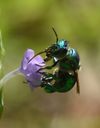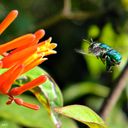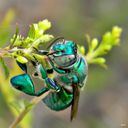Dilemma Orchid Bee
Euglossa dilemma
Classification
- Phylum: Arthropoda
- Subphylum: Hexapoda
- Class: Insecta
- Order: Hymenoptera
- Family: Apidae
- Subfamily: Apinae
- Tribe: Euglossini
- Genus: Euglossa
- Species: dilemma
Pronunciation
How to pronounce Euglossa dilemma: //juːˈɡlɒsə dɪˈlɛmə//
These audio files are automatically generated. While they are not always 100% accurate, they are a good starting point.
Images






Summary
Euglossa dilemma, or the dilemma orchid bee, is a solitary euglossine bee native to Central America and adventive in Florida. It is recognized for its brilliant metallic green coloration and unique reproductive behaviors involving the collection and use of floral fragrances during courtship.
Physical Characteristics
Brilliant metallic green with "inflated" hind legs; tongue nearly as long as body. Males have two teeth on their mandibles, while females possess a sting that is not as painful as a honeybee's sting. Membranous wings are dark-colored and translucent.
Identification Tips
May be confused with sweat bees in the family Halictidae, such as Augochloropsis, but orchid bees have much longer proboscises for gathering nectar from flowers with long corolla tubes.
Habitat
Hot, dry habitats including degraded forests, pastures, parks, and gardens in Central America; found in a variety of non-primary habitats.
Distribution
Native to Central America (Costa Rica to Mexico), adventive in Florida (detected in Broward County in 2003); expected to extend through southern Florida.
Diet
Both sexes collect nectar from various plants, predominantly from Ruellia brittoniana and Tecoma stans. The female predominantly gathers pollen from Senna mexicana and other plants.
Life Cycle
Females build solitary nests out of propolis, containing up to twenty cells; each cell has an egg laid in it along with pollen and nectar to feed the developing larvae.
Reproduction
Males attract females by releasing fragrances and fanning their wings to disperse it.
Ecosystem Role
Pollinates neotropical orchids and other flowering plants; exhibits mutualistic relationships with orchids.
Evolution
Euglossa dilemma is a newly defined species that was previously classified incorrectly as E. viridissima. Mitochondrial genetics suggests they are closely related and form a clade within Euglossa.
Similar Taxa
Misconceptions
Initial identification as Euglossa viridissima led to confusion, but it has been clarified as a distinct species.
Tags
- Euglossa
- Orchid Bee
- Mesoamerica
- Pollinators
- Biodiversity